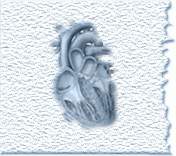|
|
|
|
|
|
|
|
|

|
 |
|
 |
|
The
heart is situated in the center of the
chest. It is approximately the size of a
closed fist of an individual's hand. It is
positioned in the middle of the chest
cavity. It is more aligned to the left,
tucked in between the two lungs.
 The
heart, a hollow muscular organ, is a pump
house of the body. As the name suggests, its
underlying function is to pump blood into
the lungs for oxygenation and then carry
this blood to the whole body. In simple
words, the heart collects oxygen-depleted
blood from the body pumping into the lungs,
where it picks up the oxygen and drops off
the carbon dioxide. The heart then collects
the oxygen-enriched blood and sends it to
the various parts of the body. The
heart, a hollow muscular organ, is a pump
house of the body. As the name suggests, its
underlying function is to pump blood into
the lungs for oxygenation and then carry
this blood to the whole body. In simple
words, the heart collects oxygen-depleted
blood from the body pumping into the lungs,
where it picks up the oxygen and drops off
the carbon dioxide. The heart then collects
the oxygen-enriched blood and sends it to
the various parts of the body.
The
arteries and veins are the carriers of the
blood. The arteries carry the pure blood
(oxygenated blood) from the heart to various
parts of the body, whereas the veins bring
the impure blood (unoxygenated blood) from
the various parts of the body, back to the
heart.
|
| Chambers
of the heart |
 |
|
The heart consists of four chambers,
two on both sides i.e. left and right side.
Each side consists of an atrium, which are the
small receiving chambers, and ventricles,
which are big pumping chambers. So the heart
consists of right atrium and right ventricle,
which receive blood from the whole body and
again pump it into the lungs. While the left
atrium and left ventricle, receive oxygenated
blood from the lungs and pump it into the
aorta, which are the main arterial highway of
our body.
The
left ventricle has to expend much more energy
than the right ventricle because; it has to
pump blood to the whole body; whereas the
right ventricle has to pump blood only into
the lungs. Obviously, the left ventricle is
much thicker and heavier of the two ventricles
and is the principal and main pumping chamber
of the heart.
|
| speed
of blood circulation |
 |
The
circulation of blood is so fast that, it can
take about five liters of mass of
blood, which passes through the body, heart
and lungs in less than a minute. So, imagine
the amount of work that the heart has to
perform throughout our lives.
|
|

|
|
|
|
![]()